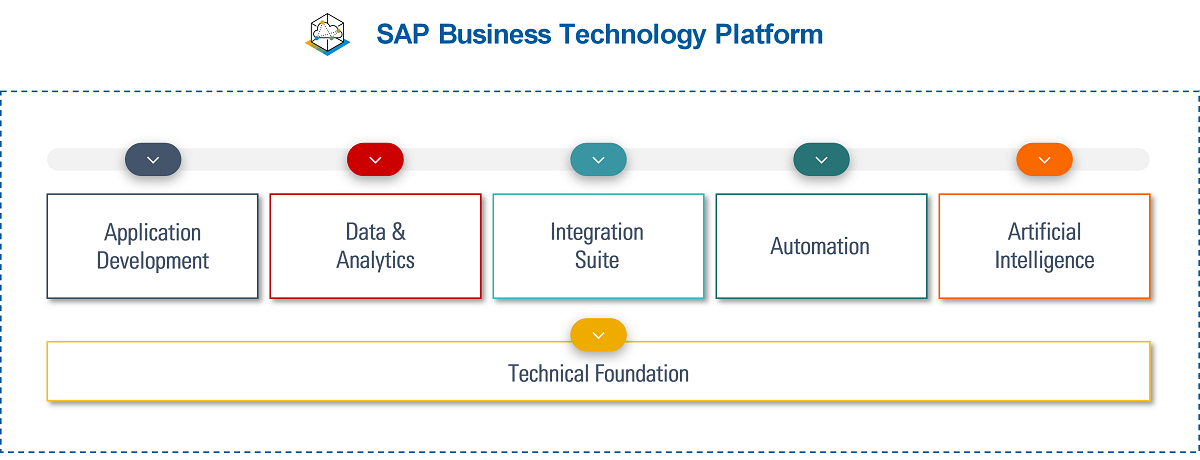Cloud
The Key Features of SAP BTP to Boost Your IS
– Apr 5, 2024

Thibault ChanasSAP Business Technology Platform (BTP) is designed to develop, extend and customize your company’s SAP landscape, particularly when migrating to SAP S/4HANA. Here, we review its many benefits and embedded technologies.
Why Integrate SAP BTP into Your Architecture?
According to SAP, the future of enterprise digital transformation is a composable ERP system, made up of a range of services and applications connected to each other in a cloud. How can this be achieved? One method recommended by SAP is to implement a “keep the core clean” strategy, avoiding custom codes and non-standard processes to keep a standard SAP S/4HANA instance at the core of the ERP system. For SAP, applying these key principles results in numerous benefits, including greater agility during upgrades and less user and non-regression testing. Moreover, keeping the core clean ensures easier access to innovation, as new services are available in the cloud without the need for updates. Last but not least, another benefit for organizations is that they can more easily adjust their architecture to changing loads.
To customize S/4HANA, three different approaches are possible using SAP tools:
- key user extensions: these are low-code or no-code graphic tools that allow limited customization of the S/4 system, standard processes, and transactions;
- on-stack developer extensions: this ABAP stack allows a more advanced level of customization, while remaining close to standard transaction kinematics;
- side-by-side extensions via SAP Business Technology Platform (BTP): these enable S/4HANA to be extended in a different context from the previous two approaches, e.g. if the users concerned are not present within the core architecture, if the computational load of an application is to be transferred outside the system, or if there is a need for proximity with other applications in the cloud. What are the benefits of the BTP solution? First and foremost, its flexibility and the ability to use tools whose technical life cycle is unconnected to that of S/4HANA, enabling them to be updated at different times. In addition, the platform offers rapid development and advanced connectivity for applications developed in it.

A Framework of Services and Apps
SAP BTP can be defined as a cloud-based framework of services and applications. The platform practices pricing similar to that of hyperscalers. In other words, businesses can choose between a “pay as you go” option, a subscription per service (with limited or unlimited use), and a Cloud Platform Enterprise Agreement (CPEA). This latter option consists of a system of tokens, or credits, purchased annually from SAP, to be distributed among the various services or applications, according to needs, to keep consumption under control.
It should be noted that SAP BTP is based on a technology base mainly hosted by Microsoft Azure, AWS or Google Cloud. Furthermore, it should be pointed out that the services and applications integrated into SAP BTP have equivalents that can be found outside the platform, notably from hyperscalers, making it possible to create hybrid landscapes between SAP BTP and hyperscalers. Nevertheless, SAP BTP affords businesses greater integration with SAP than competitor products.
SAP BTP can be seen as a platform built on a technical foundation on which each organization then builds its SAP infrastructure, containing:
- basic services to adapt your SAP BTP landscape (security, auditing, logging, connectivity, etc.) and bring it into compliance with your information system’s best practices;
- a monitoring and reporting component (alerts and automatic actions, SAP Cloud ALM, third-party tools such as Retyna from oXya, the possibility of developing application-specific dashboards).
As all these functions are available via API, it is therefore possible to connect to any component to benefit from the related data and services. The platform also includes SAP BTP Cockpit, an interface for managing users, services and connection operations, among other features.
Build Your Landscape Around the 5 Pillars of SAP BTP
Besides the technical foundation mentioned above, your enterprise SAP landscape will be shaped around five main pillars present in BTP.

1. Application Development
Opening the SAP platform, with the integration of Cloud Foundry and Kyma, is new for SAP. This pillar also includes tools such as Continuous Integration & Delivery, Business Application Studio and SAP Build Apps, for developing applications in agile mode that can easily be made accessible to any user via SAP Build Workzone.
2. Data & Analytics
In this second pillar, the Data part includes database provisioning (SAP HANA CLOUD, PROSGRESQL, etc.) for applications developed in SAP BTP, which also enables data to be replicated from your ERP, thus offering load-shifting possibilities.
On the Analytics side, there is SAP Datasphere which can unify access to data or, according to SAP, create a Business Data Lake. You will also find SAP Analytics Cloud, which offers the added benefit of an integrated AI layer for creating natural language dashboards.
3. Integration Suite
In the third pillar, and through the Cloud Connector, SAP provides pre-built models of flows and APIs, to enable communication with all types of partners, in all types of cases (A2A, B2B, B2G). Open connectors ensure easy connectivity between Integration Suite and the most common market tools (Office 365, Salesforce, Teams, etc.). Integration Suite also allows you to create, publish and sell your own APIs.
With SAP Event Mesh, SAP also brings event management to integration, providing robustness, real time, and guaranteed message transmission (when a system is unavailable). SAP Graph simplifies the technical view of the landscape using business data graphs.
4. Automation
The Automation pillar allows SAP to provide tools and services designed to automate organizational processes, the idea here being to implement internal workflows. With SAP Build Workzone, it is also possible to create automation-related dashboards and to bring all applications together in the one place, according to user needs.
5. Artificial Intelligence
The fifth and final pillar is Artificial Intelligence (AI). SAP BTP integrates AI to accelerate the development of generative AI, with features such as Joule, the AI co-pilot. The platform can be used to extend and orchestrate internal and external language models, such as Azure OpenAI. It adds intelligence to applications through pre-trained models, automating information extraction and improving decisions using data attributes and personalized recommendations. SAP BTP makes it possible to train, deploy and run AI models on a large scale, respecting data confidentiality and ensuring efficiency. In short, SAP BTP offers a comprehensive solution for fully exploiting the benefits of artificial intelligence in code development and business application improvement.
With our SAP expertise, oXya can help you integrate the SAP BTP solution. To find out more about our services, contact us here: Contact us
Other articles
Strategic SAP Management: Traditional Archiving or Modern Data Lakes?
Suharsh Anand, Solutions Architect
Read more

